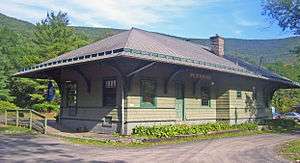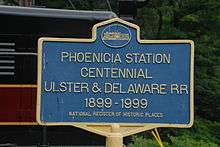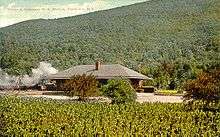Phoenicia station
Phoenicia station is a disused train station located on High Street just south of Phoenicia, New York, United States. It is a frame building dating to the end of the 19th century.
Phoenicia | ||||||||||||||||
|---|---|---|---|---|---|---|---|---|---|---|---|---|---|---|---|---|
 West elevation and north profile of Phoenicia station in 2008 | ||||||||||||||||
| Location | Station Road, Phoenicia, Ulster County, New York 12464 | |||||||||||||||
| Tracks | 1 | |||||||||||||||
| Services | ||||||||||||||||
| ||||||||||||||||
Phoenicia Railroad Station | ||||||||||||||||
  | ||||||||||||||||
| Location | Phoenicia, NY | |||||||||||||||
| Nearest city | Kingston | |||||||||||||||
| Coordinates | 42°04′49″N 74°18′30″W | |||||||||||||||
| Area | less than one acre | |||||||||||||||
| Built | 1899[1] | |||||||||||||||
| Architectural style | Shingle Style | |||||||||||||||
| NRHP reference No. | 95000474[2] | |||||||||||||||
| Added to NRHP | April 20, 1995 | |||||||||||||||
It was built by the Ulster and Delaware Railroad to replace an earlier station, serving primarily the patrons of hotels in the surrounding Catskill Mountains. It remained in use throughout the 20th century, as the Ulster and Delaware eventually was absorbed into the New York Central Railroad. It was listed on the National Register of Historic Places in 1995 as the Phoenicia Railroad Station, and today is home to the Empire State Railway Museum and a stop on the Catskill Mountain Railroad.
Property
The station is located just south of High Street, a road that leads into Phoenicia from the NY 28 state highway. It is situated in an open area on the flood plain of nearby Esopus Creek across from the southwestern foot of Mount Tremper. There is a parking lot to the south, and a kiosk to the north, but no other buildings in the area save a small sandwich shop. The track currently used by the CMRR is on the east side of the station. It is included in the Register listing as a contributing resource.[1]
The building itself is a one-story rectangular frame structure on a stone foundation sided in wood shingles. Its peaked roof, shingled in asphalt, is pierced by a stone chimney on the west side.[1]
Continuous wooden molding runs around the building where the foundation, of bluestone in an ashlar pattern, gives way to the shingles. The wall flares outward slightly between it and another molded course below the windows. The roof has a deep overhang, with exposed eaves and decorative brackets. It shelters a wooden platform, raised so that boarding stools would not be needed, at trackside.[1]
Inside, the station retains its original layout except for one closet that was built for electrical control equipment. Both the waiting room and the baggage room are now given over to museum displays. They are sided in narrow beadboard yellow pine, laid both horizontally and vertically, up to the vaulted ceiling. The floors have three-inch (7.5 cm) tongue and groove planking.[1]
Between the two rooms on the track side is the ticket agent's office, which retains its brass window bars and milk glass windows. The original benches, water fountain and sink are still in the waiting room along with an original heating grate. A cast iron air distribution pedestal was moved slightly from its original location to make room for a new electrical outlet.[1]
The track next to the station is standard gauge. It is the only one of five that were once here.[1]
History

Thomas Cornell started the Ulster and Delaware's predecessor, the Rondout and Oswego, in 1866 to get goods from Central New York to what is now Kingston, already the terminus of the Delaware and Hudson Canal, which had already established itself as the main route carrying coal from Northeast Pennsylvania to New York City via the Hudson River. Phoenicia would be for a long time the western terminus of its narrow gauge lines, with a branch, the Stony Clove and Catskill Mountain Railroad, going up Stony Clove Notch to Hunter in 1882.[1]
The first Phoenicia station was an 1870 masonry building located near the present intersection of Plank Road and Lower High Street in Phoenicia. The station's business increased when the branch was built in 1882; this led to two porticos being added, one on each side. Eventually the Ulster and Delaware would reach Oneonta. In 1899 the line was converted to standard gauge due to steady growth in its passenger service to mountain resorts.[1]

This new pre-fabricated structure (a near duplicate of the still-extant Oneonta Station, now a local bar) was the now the busiest station on the line, serving both the main line and the branch. In 1913, its busiest year, 675,000 passengers passed through.[1] Its five tracks and relocation prevented the backups that had been caused by the trains stopped at Phoenicia to load and unload passengers, since trains extended onto the nearby bridge.[3]
It also had a freight house, which served both the main line, and the branches, just like the station. In 1906 it was used as a location by Biograph for Holdup of the Rocky Mountain Express, an early nickelodeon film shot on paper, since transferred to film by the Library of Congress. Even after the Ulster and Delaware collapsed and was sold to the New York Central Railroad in 1932, the station remained busy. After passenger service was ended in 1954, the station was left to deteriorate. In 1976 Conrail ended freight service.[3]
But before it could be destroyed, John Ham, a local railroad buff, purchased the station from the New York Central, and it is currently the home of the Empire State Railway Museum, which opened there in 1985. It is also a station on the Catskill Mountain Railroad, a local tourist line that goes from Phoenicia to Cold Brook Station. The railroad is planned to go all the way to Kingston in the future, where it is currently restoring a 2-8-0 steam locomotive. There are even plans for the CMRR to go to the site of the old Grand Hotel Station.
After the Esopus flooded following Hurricane Irene in 2011, the museum building suffered damage and closed indefinitely. The museum's staff intend to repair it and reopen.[4] It has been open for self-guided tours weekends and holidays Memorial Day through Columbus Day.
References
- LaFrank, Kathleen (January 1995). "National Register of Historic Places nomination, Phoenicia Railroad Station". New York State Office of Parks, Recreation and Historic Preservation. Retrieved January 28, 2010.
- "National Register Information System". National Register of Historic Places. National Park Service. March 13, 2009.
- "The Phoenicia Station". Empire State Railway Museum. 2004–07. Archived from the original on August 14, 2009. Retrieved January 29, 2010. Check date values in:
|date=(help) - "Empire State Railway Museum". Empire State Railway Museum. 2011.

